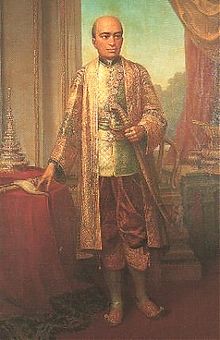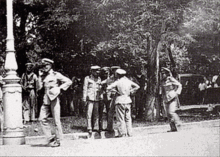രത്തനകോശിൻ രാജ്യം
| 1782–1932 | |
 A red flag with a white Sudarshana Chakra of Vishnu which is used as the symbol of Chakri Dynasty. Adopted by King Rama I (Buddha Yodfa Chulalok). | |
| Preceded by | Thonburi Kingdom |
|---|---|
| Followed by | History of Thailand (1932–1973) |
| Monarch(s) | Phutthayotfa Chulalok (King Rama I) Phutthaloetla Naphalai (King Rama II) Nangklao (King Rama III) Mongkut (King Rama IV) Chulalongkorn (King Rama V) Vajiravudh (King Rama VI) Prajadhipok (King Rama VII) |
Part of a series on the |
|---|
| Thailand പ്രദേശത്തിന്റെ ചരിത്രം |
 |
| History |
|
Sukhothai Kingdom Ayutthaya Kingdom Thonburi Kingdom Rattanakosin Kingdom 1932 to 1973 Since 1973 |
രത്തനകോസിൻ രാജ്യം (Thai: อาณาจักรรัตนโกสินทร์, IPA: [āːnāːt͡ɕàk ráttanákōːsǐn]) തായ്ലന്റിന്റെ (പഴയ സയാം) ചരിത്രത്തിലെ നാലാമത്തെതും ഇന്നുള്ളതുമായ പരമ്പരാഗതമായ ശക്തികേന്ദ്രമാണ്. 1782ൽ ആണിത് സ്ഥാപിച്ചത്. ഈ കാലത്താണ് ബാങ്കോക്ക് തലസ്ഥാനനഗരമായത്.
പശ്ചാത്തലം[തിരുത്തുക]



ചരിത്രം[തിരുത്തുക]
സ്ഥാപനം (1782–1809)[തിരുത്തുക]
വയത്നാമിന്റെ അധിനിവേശം[തിരുത്തുക]
ബർമ്മയുമായുള്ള യുദ്ധങ്ങൾ[തിരുത്തുക]
സാമ്പത്തികസ്ഥിതിയും സംസ്കാരവും മതവും[തിരുത്തുക]



സമാധാനം (1809–1824)[തിരുത്തുക]

കലയും സാഹിത്യവും[തിരുത്തുക]

സംഘടന (1824–1851)[തിരുത്തുക]


ജ്ഞാനോദയം (1851–1868)[തിരുത്തുക]


ധമ്മയുത്തിക നികായ[തിരുത്തുക]


-
Ordination Hall of Wat Bowonniwet Vihara.
-
Surrounding wall at Wat Bowonniwet Vihara
-
Tympanums of Phra Ubosot, Wat Bowonniwet Vihara.
പരിഷ്കരണം (1868–1910)[തിരുത്തുക]



രാജഭരണത്തിൽനിന്നും ആധുനിക രാഷ്റ്റ്രത്തിലേയ്ക്ക് (1910–1925)[തിരുത്തുക]


വിദ്യാഭ്യാസ പരിഷ്കരണം[തിരുത്തുക]
-
Vajiramonkut Building, main school building, Vajiravudh College.
-
Vajiravudh College.
-
Maha Chulalongkorn Building, Chulalongkorn University.
ഒന്നാം ലോകമഹായുദ്ധം[തിരുത്തുക]

|

|
| King Rama VI by royal command changed the national flag of Siam in 1917. From the white elephant on a red background to a design with colours inspired by those of the Allies. |

പൂർണ്ണമായ ഭരണത്തിന്റെ അന്ത്യം (1925–1932)[തിരുത്തുക]

വിപ്ലവം[തിരുത്തുക]

സംസ്കാരം[തിരുത്തുക]
വസ്ത്രധാരണരീതി[തിരുത്തുക]
Architecture[തിരുത്തുക]
ഇതും കാണൂ[തിരുത്തുക]
- Coronation of the Thai monarch
- List of kings
- Kings' family tree








